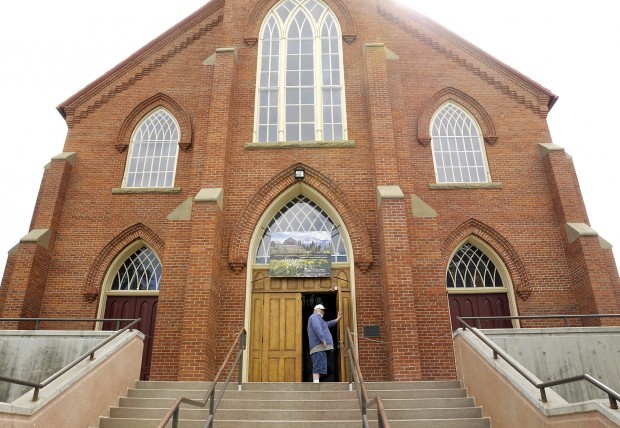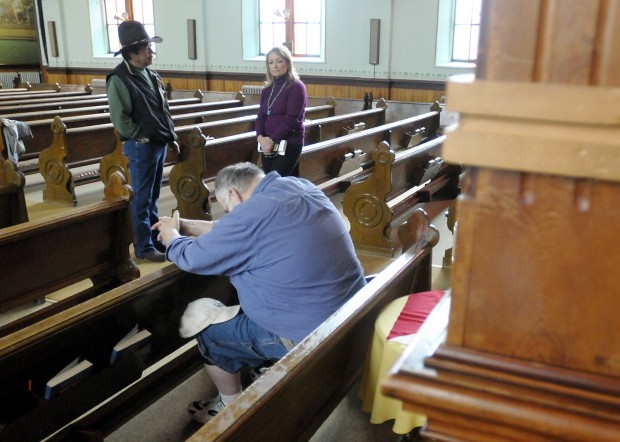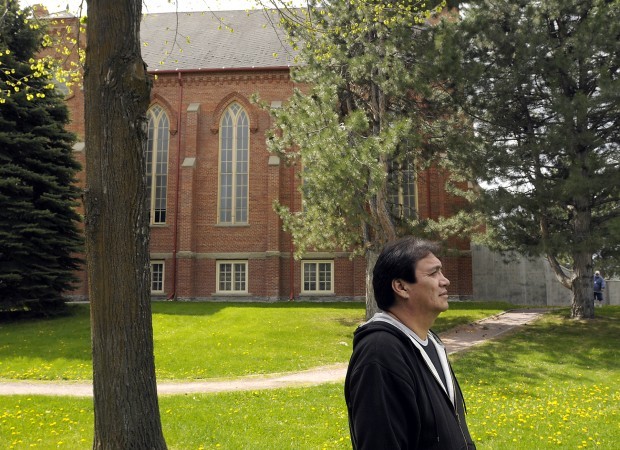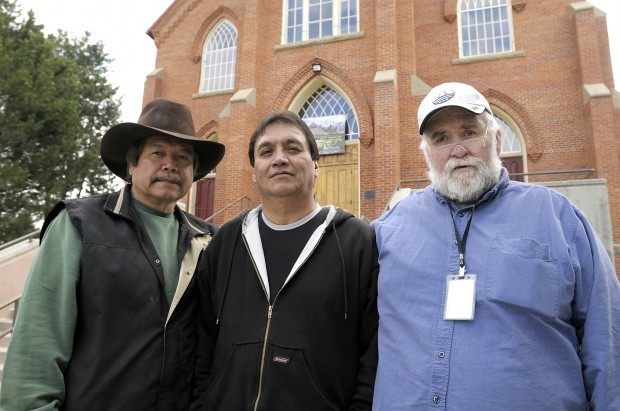Anguish Has Never Healed for Natives Physically, Sexually Abused at St. Ignatius Mission
By Gwen Florio
The Missoulian
June 5, 2011
http://missoulian.com/news/local/article_69bdf266-8f27-11e0-aa65-001cc4c002e0.html
[See Part Two: Silence Shrouds St. Ignatius Jesuit Abuse Case As Settlement Vote Nears.]
St. Ignatius – The small brick mission is a jewel, stunning in its setting at the foot of the Mission Mountains.
"I want to be here," says Garry "Bob" Salois, "the day an earthquake brings this place down."
Its 58 striking frescoes, painted by an Italian Jesuit who was self-taught, include a life-size image of St. George slaying a dragon with a hideous human face.
"The dragon's face," says Francis "Franny" Burke, "should be Mother Loyola."
The church has been a focal point of religious life in the Mission Valley since the 1830s, when the local Salish tribe sent repeated delegations to St. Louis, asking that the Jesuit "black robes" establish a mission here.
 |
| Garry Salois pauses recently at the entrance of the St. Ignatius mission. For Salois, who is Salish-Cree and French, the church reminds him of the physical and sexual abuse he suffered as a young boy at the hands of Jesuit priests or Jesuit-supervised nuns. Tom Bauer / Missoulian |
"People hate us belittling our town and our church," says Leland "Jimi" Hewankorn, "but they don't know what hell we went through."
Salois, Burke and Hewankorn are among some 500 people - nearly all of them Native American or Alaskan Native - who prevailed in a $166.1 million bankruptcy reorganization against the Oregon Province of the Society of Jesus, better known as Jesuits.
Claimants reported abuse either by Jesuit priests or nuns under Jesuit supervision, starting in the 1950s at boarding schools and parishes on remote reservations and tiny, far-flung villages around the Northwest and Alaska. The Oregon Province covers Oregon, Montana, Washington, Idaho and Alaska.
The settlement, announced in March, is the largest against a Catholic religious order and one of the biggest involving abuse by Catholic clergy.
For the past several weeks, claims adjudicators have been verifying accusations. Last week, ballots went out to claimants, who have until June 30 to approve the reorganization plan.
In August or September, those victims - many of them approaching old age - should start receiving large cash settlements for the anguish inflicted upon them as children.
A half-century after the abuse began, Salois, Hewankorn and Burke say that anguish lingers.
"For over 50 years, those guys have messed up my head, the way that I think," said Salois. "It's like they stole my whole damn life."
******
The three men, now in their late 50s, said they still avoid the St. Ignatius mission church.
But recently they returned to tell their story, lingering uncomfortably outside before going in, pointing out where the dormitory and other mission buildings, now long gone, once stood.
"The only thing left is the church," said Burke.
"And," added Salois, "the bad memories."
They never wanted to go to the school. They didn't have a choice.
"My mom said they threatened to put her in jail if they didn't send me," Burke said.
They arrived speaking little English. They learned some words fast.
"Dirty."
"Pigs."
"Dumb Indians."
 |
| Leland Hewankorn, left, and Salois pause inside the mission they say they’ve rarely visited since the days of their abuse while at the boarding school. Photo by Tom Bauer / Missoulian |
And to Salois, who is Salish-Cree and French - "a little, redheaded, chubby, good-looking half-breed," he described himself - "You aren't even a real Indian. You look like a white guy."
This, they said, from a woman who supposedly was "civilizing" them.
Mother Loyola was the Ursuline nun in charge of the boys' section of the boarding school.
"A big woman," Hewankorn recalled.
"German," said Burke. Salois' older brother, also at the school, theorized that she was a Nazi war criminal hiding within a nun's habit.
"We thought she was a man," Burke said. "We used to peek through the keyhole to see."
Later, said Salois, "we found out she wasn't. The hard way."
******
Most of the sexual abuse cases against the Catholic church involve priests.
Of nearly 3,500 accused Catholic religious leaders whose names have been released, only 82 - about 2 percent - are nuns, according to Bishop Accountability, a group that tracks church sexual abuse cases.
An extensive study by John Jay College of Criminal Justice for the U.S. Conference of Catholic Bishops, released last month, focuses solely on priests. (One of its conclusions, tying the incidence of abuse to more permissive social mores of the 1960s, has been widely criticized.)
"People don't believe females are capable of abusing, and they surely don't think these good nuns would abuse," said Steve Theisen, director of the Iowa chapter of the Survivors Network of Those Abused by Priests, or SNAP. As the group's name indicates, abuse by nuns is so little recognized that there's not even a support group for its victims - who include Theisen.
"It's really one of the last taboos to try to break," he said.
 |
| Francis Burke walks the grounds outside the St. Ignatius mission recently. Burke, like many other abuse victims, says it caused him years of alcohol and drug abuse. Photo by Tom Bauer / Missoulian |
In the Northwest Jesuits case, the Pfau Cochran Vertetis Amala law firm of Seattle crunched numbers of the accused and the allegations against them, and came up with a list of the Top 10 worst offenders.
St. Ignatius' Mother Loyola is No. 7 on a list that includes Father Augustine J. "Freddy" Feretti and Brother Rene "Charlie" Gallant, both of whom also served at the St. Ignatius mission.
"The focus has certainly been the priests, but the nuns play a real interesting role. ... We see a lot of complicity by the nuns in the priest abuse," said attorney Michael Pfau.
Sister Francis Xavier, the archivist at the Ursuline Centre in Great Falls, knew Mother Loyola personally and remembers her reputation as a "rather severe disciplinarian." But she dismissed as rumor the possibility that Mother Loyola strayed into sexual abuse. "She may have - we used to call it spanking. But fondling is something I find hard to believe," she said.
That's a common reaction to accusations of abuse by women, said Bryan Smith, an attorney with Tamaki Law in Yakima, Wash., which represents about 90 of the people in the Northwest Jesuit case. The Tamaki clients, who include Salois, Hewankorn and Burke, make up the largest group of those in the lower 48 states.
"It was shocking for me to hear" the allegations about Mother Loyola, said Smith, who took depositions from many of the claimants.
"It wasn't until I heard multiple accounts that were remarkably similar from people who didn't know each other that I started to realize, 'This is real stuff that was happening.' "
*****
The accounts were similar and so were the victims, at least during the late 1950s and early 1960s in St. Ignatius.
"I think they looked everybody over and picked on the ones that didn't talk English," Burke said. "The ones who came from traditional families," added Salois.
The three fit the bill. Burke and Hewankorn spoke mostly Kootenai, Salois a mixture of Salish and Cree. Besides, they were boarding students. Unlike the "day scholars" who went back to their families at night, the boys were far from their homes on the reservation's northern border. (The boarding program closed in 1962.)
Their heads were shaved. Verbal abuse escalated to physical, meted out for supposed infractions - say, speaking their own language.
"We'd have to pull down our pants to our ankles and get hit with a 2-by-4," said Hewankorn. "And also hold out our hands, palms up, and get hit with a 2-by-4. I always wondered how they could be so mean."
Strict regimens forbade little kids from getting up in the middle of the night. If a boy wet his bed, said Salois, he would be forced to stand with the soaked sheets draped over him until they dried, then wash the sheets and stand again, ghostlike beneath them, until the clean sheets dried.
Separately, they ran away. When he was in second grade, Hewankorn made it to Elmo, more than 40 miles away, before police brought him back. Burke got as far as a barn, visible from the dorm, and realized he'd never make it home to Elmo. He sneaked back, but was found out, and his head shaven anew as punishment. Salois ran repeatedly. "I was always bald," he said.
Physical abuse turned sexual.
When the Rev. Joseph Balfe asked Burke to assist him with Mass, Burke went to the sacristy, only to be confronted with Balfe standing naked. During confession, Balfe asked Hewankorn what bed he slept in.
 |
| Hewankorn, Burke and Salois stand outside the mission. They’re among some 500 people who recently reached a settlement with the Oregon Province of the Society of Jesus for reported abuse, but they say what they really want is an apology. Photo by Tom Bauer / Missoulian |
"They looked at us like we were animals. Like we were their playthings," said Burke.
They quickly learned to hide when Mother Loyola came around, looking for a boy to help a priest with "chores."
But at night, when she came into the dormitory, there was nowhere to go, they said.
"I'd see Mother Loyola go to different beds," Hewankorn said.
"She'd put her hand over your mouth," said Salois. "Grab you by the ear and take you back to her room" for sex.
Another nun, elderly, would coax boys onto her lap and force their heads to her bared chest.
"Sister John was a pervert, but she was senile," Salois said. "She tried to breast-feed you and say, 'My poor baby.' But at least you'd get a hug and not get hurt."
They tried to tell, they said. As youngsters, they wrote a letter to the bishop in Helena, and even to the Pope.
"We complained about how we were being treated. ... We said, 'Come and save us,' " Burke said.
"I guess that letter never made it."
******
The settlement could bring as much as a half-million dollars to some victims, depending upon the length and severity of the abuse.
So what, said Hewankorn. "All that money, they could give it all to me and it still wouldn't be enough for the abuse that I went through."
Money won't make up for his shattered life, his three marriages, he said. "I can't hold onto relationships," he said. He is immersed in "shame, shame."
Salois tried three times to kill himself, once before he was a teenager.
"I turned violent, into a drug addict and an alcoholic," said Salois, who has "L-O-V-E" tattooed on the four fingers of one hand and "H-A-T-E" on the other.
He said he got into the habit, for a while, of going into Catholic churches and waiting until Mass was over before confronting the priest.
"I'd yell at him, cuff him a couple of times. Ask them why they did it."
Burke likewise drank and drugged through years of his life. He said he's been sober 10 years now. He's only recently begun to discuss his childhood with his grown children. "They saw me cry," he said.
But until last month, the only times he'd been inside the St. Ignatius church since third grade involved mandatory events like wakes or funerals.
"My knees are shaking," he said. "It's really hard. You know, this is supposed to be a good place."
He paced past the murals, barely looking at them. He, like the others, turned his back on Catholicism as a little boy, and never looked back. None of his eight children is baptized.
"I feel like I'm lost," he said. "I don't know my heritage. I can't speak English very good, and I can't speak my own language."
Salois also refused to baptize his children and won't allow his grandchildren to be baptized. "It took me 40 years to separate the Catholic religion and belief in God," said Salois, who despite his palpable anger took off his cap when he entered St. Ignatius church. "I believe there's got to be a creator of all things. But if Jesus Christ and his bunch are a true religion, he's forsaken me a long time ago."
Hewankorn has worked to reclaim his tribal heritage, turning to traditional ways.
"I don't go to church no more," he said. "I confess to Him only. I don't confess to a human being."
The men said they're waiting for something more valuable than money.
"I got over being angry," Burke said. "But I want an apology. Not for myself, but the whole Indian race."
Salois hopes the Rev. Patrick Lee, the leader of the Oregon Province, comes to St. Ignatius to apologize in person - although at the thought, his anger flashed anew.
"I'd tell him, I don't accept your apologies. It's too damn late," he said. But a moment later, he added, "I'd go and see what kind of apology he gives. If it's a real one, I'll accept it. But if it's one of their old phonies, I'll spit in his face and go away."
And Hewankorn wants to ask the old, unanswerable question.
"Why? Why did you do that to us?"
Reporter Gwen Florio can be reached at 523-5268, gwen.florio@missoulian.com or CopsAndCourts.com.
Any original material on these pages is copyright © BishopAccountability.org 2004. Reproduce freely with attribution.